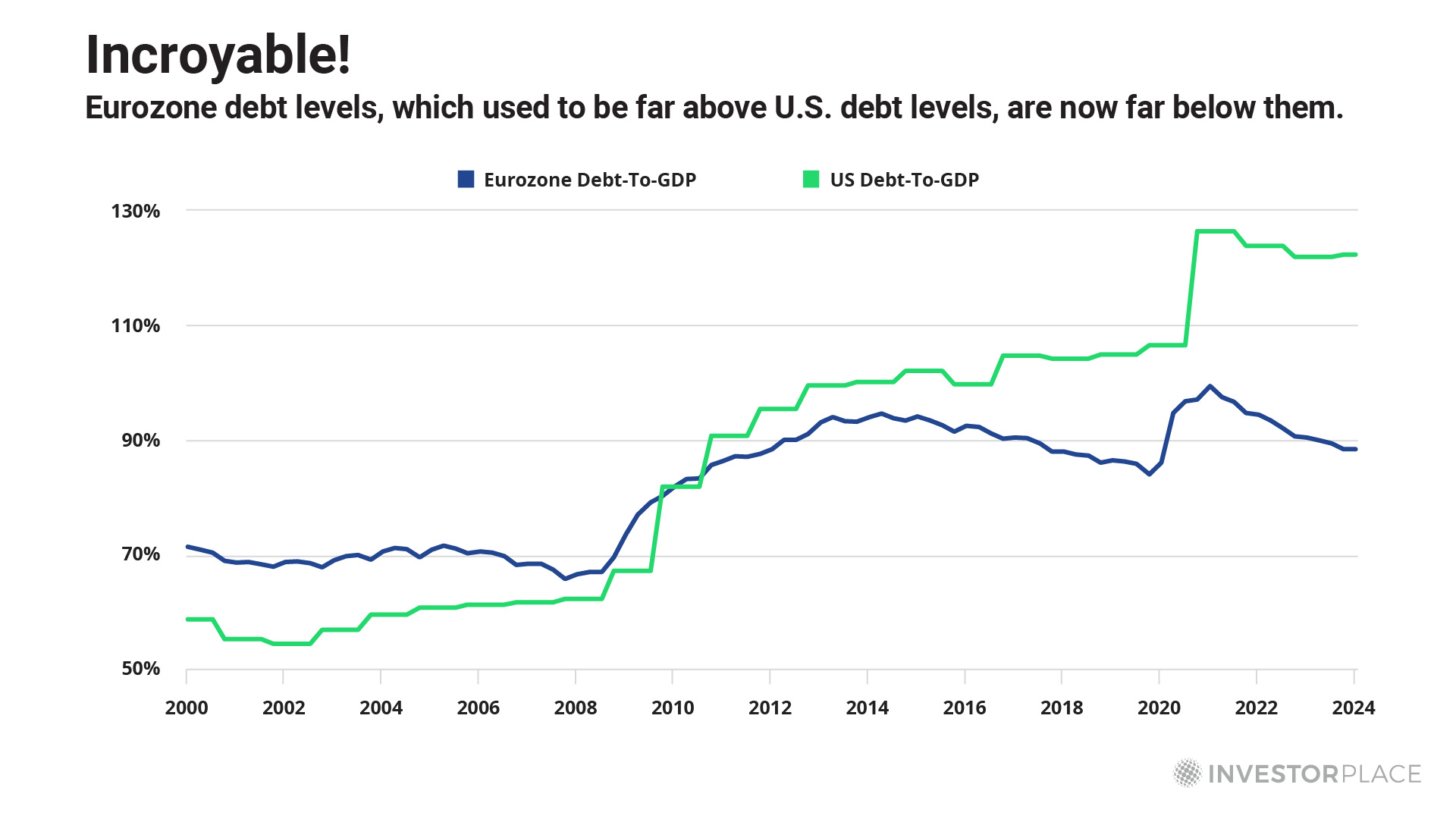
Hello, Reader.
Starting today, we’re going to be doing something a little different on Mondays in Smart Money…
At the start of each week, I’ll now present you with your Smart Money Weekly Roundups.
In these roundups, I’ll first share a “Chart of the Week,” along with some commentary to help you turn my data findings into a profitable opportunity. Then, we’ll recap what my team and I covered here in the previous week.
So, without further ado, let’s get to it…
Nearly three decades ago, Morgan Stanley’s Investment Strategist, Byron Wien, snarked that the European economy was becoming “a vast open-air museum.”
At that time, the fledgling European Union (EU) had just booked a hefty 7% budget deficit; and the survival of its experimental new currency, the euro, was far from guaranteed.
Meanwhile, on the other side of the Atlantic, a robust U.S. economy was showering the federal coffers with tax dollars. During the preceding four years, the annual U.S. deficit had contracted from 5% to just 1.3%, on its way to notching for straight budget surpluses.
But those glory days are long gone. The U.S. has not balanced its books since 2001 and has been spilling red ink ever since. By contrast, the European Union has overcome most of its early growing pains to become a fiscally responsible member of the global economy, at least relatively speaking.
As the chart below shows, the balance sheets of the European Union and the U.S. have traded places during the last 25 years. Back in 2000, U.S. federal debt totaled less than 60% of GDP, while Eurozone debt equaled 72% of GDP.
Over the intervening years, Eurozone debt has inched marginally higher to 89% of GDP, while U.S. debt levels more than doubled to 128% of GDP.

In olden times, many economists considered a debt-to-GDP ratio above 100% to be a “banana republic” condition. But now that we Americans are the ones growing bananas, most economists simply look the other way.
The current U.S. debt load may not be fatal, but it isn’t ideal. At the margin, it limits our future spending options, constrains our financial flexibility, puts upward pressure on inflation rates and downward pressure on the U.S. dollar’s value.
This titanic debt load may be one reason why the U.S. inflation rate is not falling as rapidly as it is in Europe and other parts of the world. And since the “inflation bone” is connected to the “rate cut bone,” the Federal Reserve has been hesitant to begin reducing interest rates.
Not so in Europe…
Last week, the European Central Bank reduced interest rates for the first time in five years. And it did so for one main reason: because it can.
The Eurozone inflation rate has dropped from a high of 10.6% in 2022 to a recent reading of just 2.4%. The U.S. inflation rate is 40% higher at 3.4%.
Canada and Switzerland also cut interest rates last week, as their inflation readings have fallen to just 2.7% and 1.4%, respectively.
Keep an eye on this trend, as it could boost the growth potential of European stocks over the coming months, especially considering their steep valuation discount to U.S. stocks.
At present, the Euro STOXX 50 Index is trading for less than 15 times earnings, compared to 25 times earnings for the S&P 500 Index.
The bottom line is that European stocks deserve a close look.
And speaking of a closer look… let’s take a look back at what we covered here at Smart Money issues over the last week.
Smart Money Roundup

GameStop’s Surge Highlights the Power of an Unusual Trading Strategy
At Smart Money, we typically cover the more “traditional” methods of global macro analysis. The global macro investing thesis tells us that every cause has some predictable effect, and smart investors can often get ahead of that curve. But global macro investing also has a “reflexive” component, where the effect creates the cause. Today, that “reflexive” component is alive and well in so-called meme stocks. Let’s explore this concept a bit more. Read more here.

Three Stocks to Buy and Hold Forever
While there is no perfect investment method, there is a way to allocate your assets intelligently. This will then help you set yourself up for the best chance at success. Now, there are multiple facets to this strategy, but the one I want to focus on today is stocks to buy and hold forever. So, here are three stocks that I consider to be some of the best “Forever Stocks” out there. Click here to continue reading.

Why You Should Make Room for Data Centers in Your Portfolio
All eyes are locked on the AI arena, watching tech titans clash over whose AI system takes the crown. But look past the bright lights and roars of the AI battlefield, and you’ll spot another exciting campaign raging in the shadows… The surprisingly merciless data center war. So, let’s take a look at the current cloud computing behemoths and what it all means as an investment opportunity. Learn more here.
Looking Ahead
I’ll be back in touch with your next Smart Money on Wednesday, where we’ll continue to discuss the trends that I’m currently keeping a close eye on.
And keep an eye out later in the week: I will dive deeper into these big-picture trends – those that drive huge, multiyear moves in entire sectors of the market – in my Fry’s Investment Report June issue, which will be available this Friday. (Fry Investment Report members can log in here).
Regards,
Eric Fry






